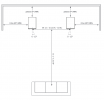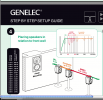Definitely.
I simply added the data as
@BrokenEnglishGuy mentioned/asked about kef's suggestions.
I always take under consideration what is the genetir guidelines of the manufacturer, knowing though that what will determine the final placement is the room.
I my case 30cm from back wall was the minimum distance the wall stopped interfering negatively(to my ears) with the speakers. I now have them at 45cm. As for the boundaries I would say everything above 50cm will work. Regarding the listening distance, I tried different placements between 2m and 3m with no audible, other than loudness, difference I would say.
If you say you are boundaries restricted the bigger speaker will be a bigger 'problem' in theory. Or not? You also say you intend to place them nearfield. In my opinion the best choice of R series for you usage scenario is R3. Give them a try and I am pretty sure you will be fully satisfied.

 www.audiosciencereview.com
www.audiosciencereview.com

 www.audiosciencereview.com
www.audiosciencereview.com


